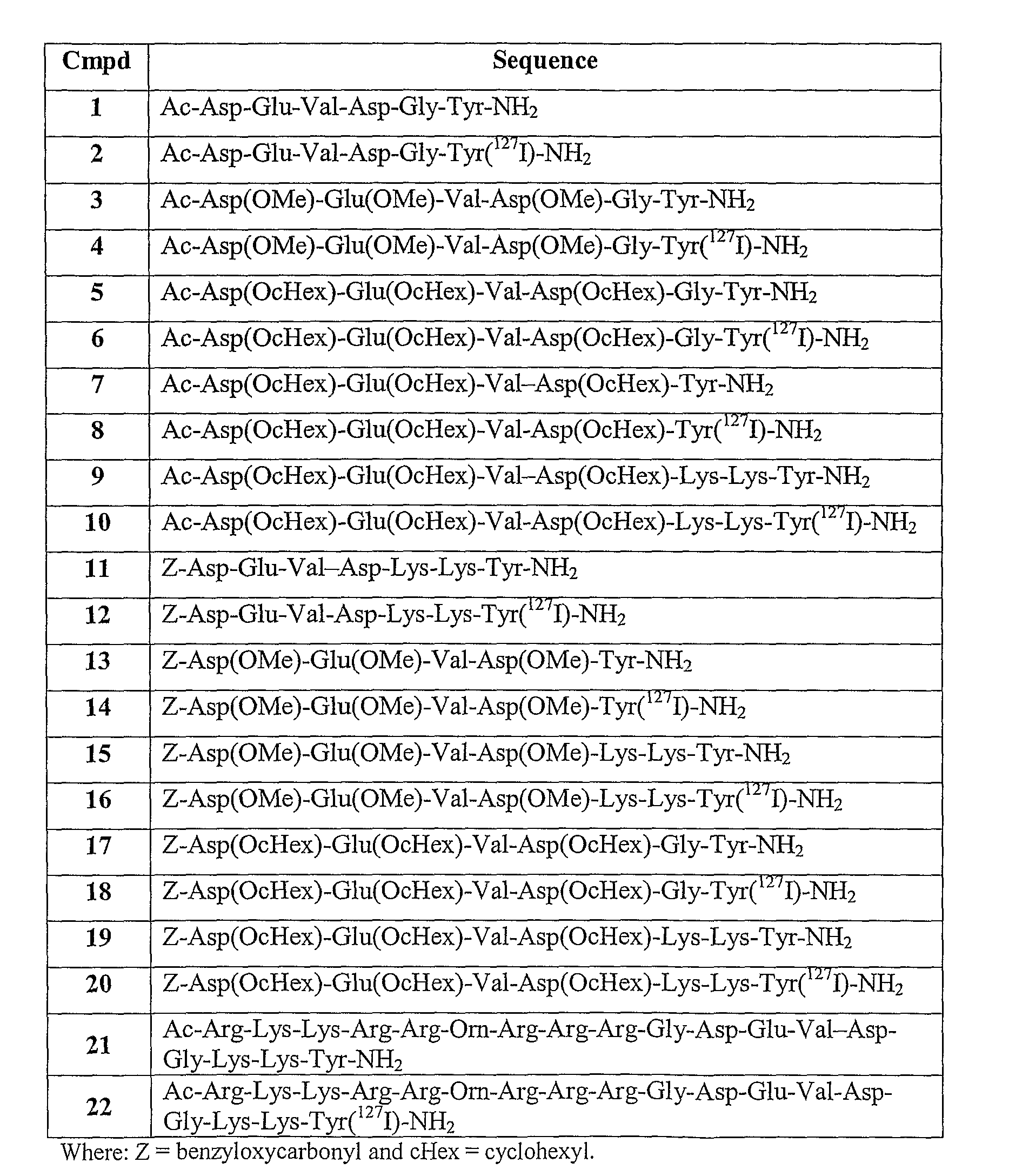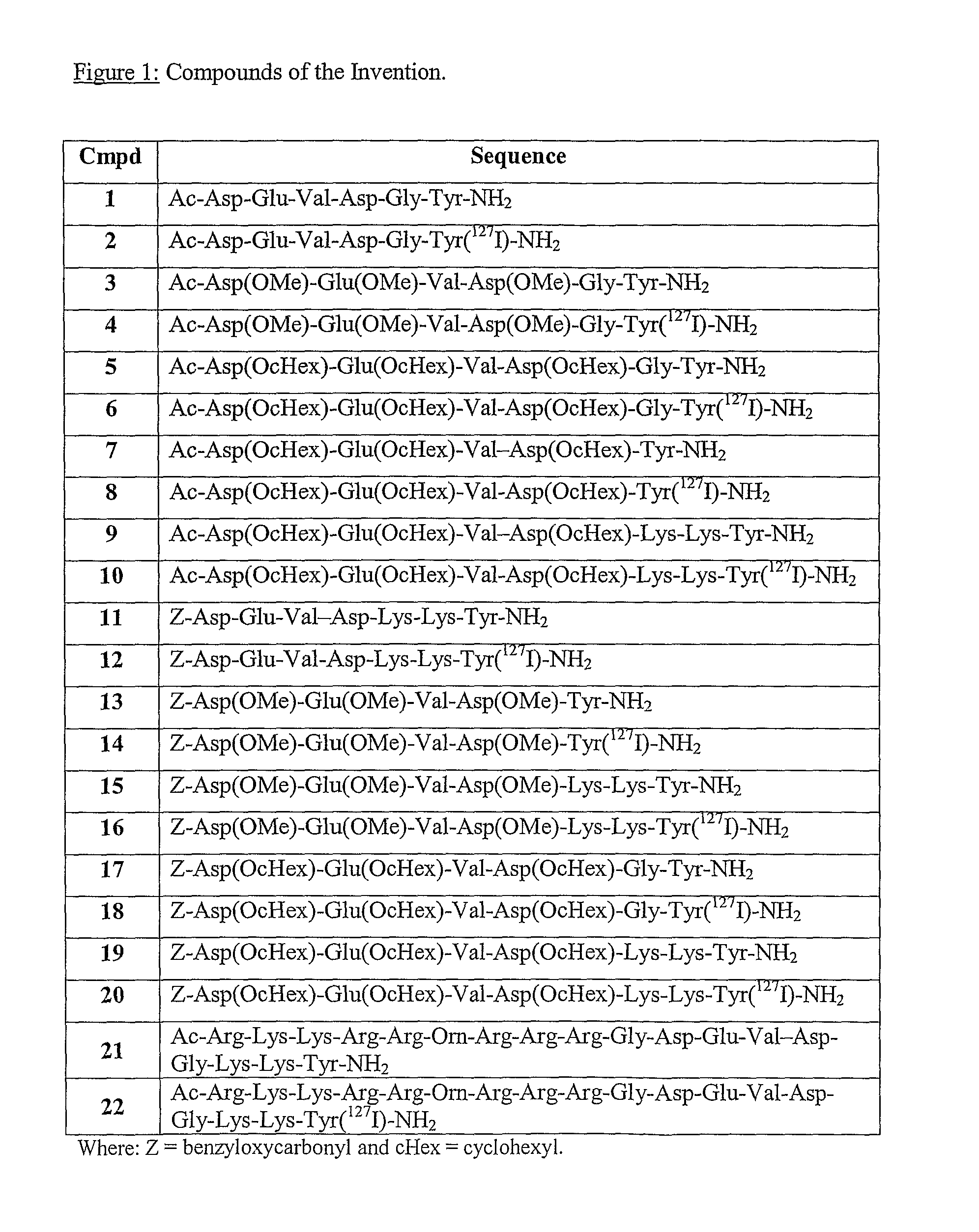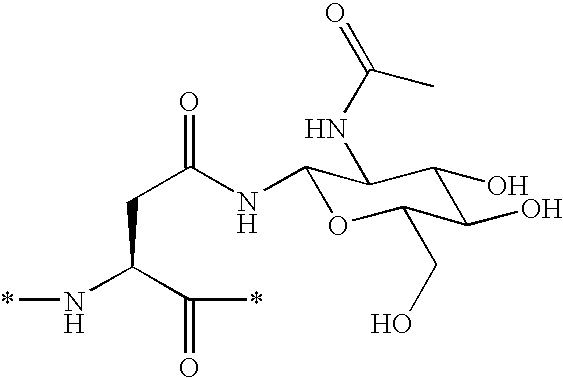Caspase-3 Substrate Comprising Imaging Agents
a substrate and imaging agent technology, applied in the direction of tetrapeptide ingredients, enzymes, radiation therapy, etc., can solve the problems of insufficient cell death, inability to regulate apoptosis, unsuitable clinical decision-making in patients with acute coronary syndrome, etc., and achieve good blood clearance and rapid imaging
- Summary
- Abstract
- Description
- Claims
- Application Information
AI Technical Summary
Benefits of technology
Problems solved by technology
Method used
Image
Examples
example 1
Synthesis of Compounds 1-22
a) Peptide Synthesis
[0121]The peptidyl resin corresponding to the sequences of Compounds 1-22 in FIG. 1 were assembled by standard solid-phase peptide chemistry [Barany et al, Int. J. Peptide Protein Research 30, 705-739 (1987)] on a Rink Amide resin (from NovaBiochem, typical loading 0.73 mmol / g). An Applied Biosystems (Perkin Elmer) model 433A peptide synthesizer was used. The residues (from the carboxyl terminus) were assembled on a 0.25 mmol scale using single couplings (2.5 hours coupling cycles) of a 4-fold molar excess of Fmoc-amino acids (1 mmol cartridges) pre-activated with 2-(1H-benzotriazol-1-yl)-1,1,3,3-tetramethyluronium-hexafluorophosphate (HBTU) / 1-hydroxy-benzotriazole (HOBt) / diisopropylethylamine (DIEA) in NMP. Fmoc-deprotection was achieved with conductivity monitoring using 20% piperidine in N-methylpyrrolidone (NMP). The washing solvent was NMP. The amino acid-side chain protecting groups used were either tert-butyl (tBu) or cyclohexyl ...
example 2
Synthesis of 123I-Labelled Compound 2 (Compound 2A)
Step (a): 127I-Analogue (Compound 2).
[0127]Compound 2 was prepared following the reaction scheme:
[0128]Mass spec analysis of 127I prepared and purified material, confirmed identity.
Step (b): Preparation of Compound 2A.
[0129]To Compound 1 (7411g, 1×10−7 moles) dissolved in 74 μl water, was added 200 μL pH 4, 0.2M ammonium acetate buffer, 10 μl Na127I in 0.01MNaOH (1×10−8 moles), ca. 10-30 μl (150-450 MBq) Na123I in 0.05M NaOH and 10 μl 0.001 M PAA solution (1×10−3 moles). [123I]-Compound 2 was HPLC purified and diluted in pH 7.4, 50 mM sodium phosphate buffer to 20 and 100 MBq / ml with specific activities of 14 and 45 MBq / nmole respectively. Co-elution with the 1271 standard was observed confirming identity. Good stability (>90%) was observed over 3.5 hours post dilution.
example 3
Synthesis of 123I-Labelled Compound 6 (Compound 6A)
Step (a): 127I-Analogue (Compound 6).
[0130]Compound 6 was prepared following the reaction scheme:
[0131]Mass spec analysis of 127I prepared and purified material, confirmed identity.
Step (b): Preparation of Compound 6A.
[0132]Compound 5 (98 μg, 1×10−7 moles) dissolved in 98 μl methanol, was added to 100 μl pH4, 0.2M ammonium acetate buffer, 10 μl Na127I in 0.01M NaOH (1×10−8 moles), ca. 10-30 μl (150-450 MBq) Na123I in 0.05M NaOH and 10 μl 0.001M PAA solution (1×10−8 moles) post iodonium formation. Compound 6A was HPLC purified and diluted in pH6, 50 mM sodium phosphate buffer to 20 and 100 MBq / ml with specific activities of 13 and 43 MBq / nmole respectively. 10% ethanol was added to aid solubility. Co-elution with the 127I standard was observed confirming identity and Compound 6A. Good stability (>90%) was observed over 3.5 hours post dilution.
PUM
| Property | Measurement | Unit |
|---|---|---|
| permeable | aaaaa | aaaaa |
| gamma-emitting radioactive | aaaaa | aaaaa |
| positron-emitting radioactive | aaaaa | aaaaa |
Abstract
Description
Claims
Application Information
 Login to View More
Login to View More - R&D
- Intellectual Property
- Life Sciences
- Materials
- Tech Scout
- Unparalleled Data Quality
- Higher Quality Content
- 60% Fewer Hallucinations
Browse by: Latest US Patents, China's latest patents, Technical Efficacy Thesaurus, Application Domain, Technology Topic, Popular Technical Reports.
© 2025 PatSnap. All rights reserved.Legal|Privacy policy|Modern Slavery Act Transparency Statement|Sitemap|About US| Contact US: help@patsnap.com



